
Mythological References in Stonehenge II Painting Titles
The Stonehenge Series II
40" x 60" (43" x 63" framed) three paintings
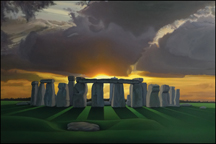
Stonehenge Series II, Kaakwha (Seneca Tribe) 40 x 60 inches, Oil on Panel, 2013
Also known as Hawenniyo, The ‘Old Man’ or ‘Grandfather Sky God’ of the Seneca. He is the personification of the eternal sun. His lodge is on the other side of the earth where he goes to retire every night
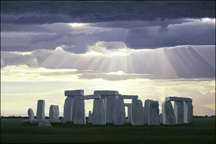
Stonehenge Series II, Unelanuhi (Cherokee Tribe) 40 x 60 inches, Oil on Panel, 2013
Unelanuhi the sun goddess of the Chreokee. Originally the earth had no sun: it was Spider Woman who pulled Unelanuhi into the sky from the underworld after the other animals had tried and failed. Although Unelanuhi belongs to no one, she is her brother’s lover, the moon, and they chase each other through the heavens. Her name means "apportioner," for Unelanuhi
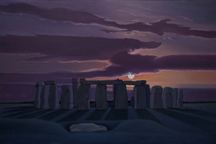
Stonehenge Series II, Tsukiyomi (Japan) 40 x 60 inches, Oil on Panel, 2013
The male moon god in Shinto and Japanese mythology. The name Tsukiyomi is a combination of the Japanese words for "moon; month" (tsuki) and "to read; to count" (yomu). Tsukuyomi was the second of the "three noble children" born from a mirror made of white copper. After climbing a celestial ladder, Tsukuyomi lived in the heavens with his sister Amaterasu, the sun goddess. Tsukuyomi angered Amaterasu when he killed a goddess of food. When Amaterasu learned what happened and she was so angry that she refused to ever look at Tsukuyomi again, forever moving to the opposite side of the sky.
60" x 40" (63" x 43" framed ) five paintings
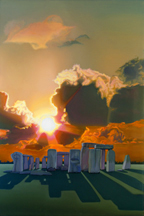
Stonehenge Series II, Chukwu (Igbo Tribe, Eastern Nigeria) 60 x 40 inches, Oil on Panel, 2013
Chukwu is the infinitely powerful, undefinable, indefinable, absolute supreme deity encompassing everything in space including space itself, in traditional Igbo spiritual belief system and mythology. Chukwu combines the concept of creator of deities for all we know and are aware of including the concept of a solar deity. According to the Igbo people from the eastern region of Nigeria Chukwu is a supreme God represented by the sun. The ancient God is not humanized in Igbo tradition belief. Because the igbo deities Amadioha and Ikenga are masculine, Chukwu is referred to as being male.
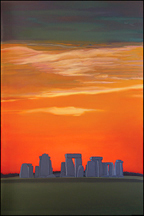
Stonehenge Series II, Wakahirume (Japan) (pronounced wa-ka-HEER-oo-may) 60 x 40 inches, Oil on Panel, 2013
Wakahirume is the Japanese Goddess of the rising sun and of weaving. She is the younger sister of Amaterasu daughter of Izanami and Izanagi. Wakahirume was a fantastic weaver and she was often to be found in Amaterasu’s weaving halls, creating garments for all the Gods. When their brother Susanoo flew into a rage against Amaterasu, he threw a skinned pony into the hall. Wakahirume was so startled that she fell onto her shuttle and died. It was her grief over Wakahirume’s death that drove Amaterasu to hide herself away in a cave. In the third century CE, Empress Jingu established the Ikuta Shrine in honor of Wakahirume, one of the oldest shrines in Japan. Wakahirume’s name means “young day woman.”
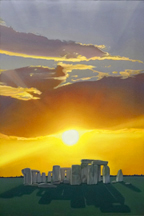
Stonehenge Series II, Kephri (Ancient Egypt) 60 x 40 inches, Oil on Panel, 2013
Kephri, (also spelled Khepera, Kheper, Khepra, Chepri) is a god in ancient Egyptian religion. Khepri was connected with the scarab beetle (kheprer), because the scarab rolls balls of dung across the ground, an act that the Egyptians saw as a symbol of the forces that move the sun across the sky. Khepri was thus a solar deity. Young dung beetles, having been laid as eggs within the dung ball, emerge from it fully formed. Therefore, Khepri also represented creation and rebirth, and he was specifically connected with the rising sun and the mythical creation of the world. The Egyptian connected his name with the Egyptian language verb kheper, meaning "develop" or "come into being"
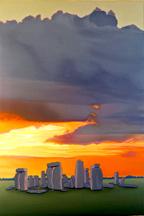
Stonehenge Series II, Ngai (Maasai) 60 x 40 inches, Oil on Panel, 2013
The Maasai (Kenya) believe that Ngai is the god of the sun, love, and was the creator of the world; in another one of their traditions, this god married Olapa (the goddess of the moon). He rules over life and death.
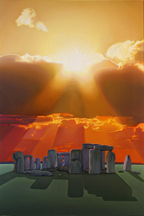
Stonehenge Series II, Sunna (Norse) 60 x 40 inches, Oil on Panel, 2013
Sunna is the Norse Goddess of the Sun, also known as Sol, though some hold that Sol is the mother and Sunna Her daughter. In Norse mythology, the Sun is female while the Moon is male. When the world was created from the body of the dead giant Ymir by the triad of Odin, Vili, and Ve, the Sun, Moon and Stars were made from the gathered sparks that shot forth from Muspellsheim, the Land of Fire.
Sunna drives the chariot of the Sun across the sky every day. Pulled by the horses Allsvinn ("Very Fast") and Arvak ("Early Rising"), the Sun-chariot is pursued by the wolf Skoll. It is said that sometimes he comes so close that he is able to take a bite out of the Sun, causing an eclipse. Sol's father is Mundilfari, and She is the sister of MÂni, the Moon-god, and the wife of Glaur or Glen ("Shine"). As Sunna, She is a healer.
At Ragnarok, the foretold "Twilight of the Gods" or end of the world, it is believed the Sun will finally be swallowed by Skoll. When the world is destroyed, a new world shall be born, a world of peace and love, and the Sun's bright daughter shall outshine Her mother.
48" x 36” (51" x 39") five paintings

Stonehenge Series II, Tezcatlipoca (Aztec) 48 x 36 inches, Oil on Panel, 2013
The Earth" was ruled by Tezcatlipoca but destroyed by Quetzalcoatl when he struck down Tezcatlipoca who then transformed into a jaguar. He was also central deity in Aztec religion. One of the four sons of Ometeotl, he is associated with the darkness, night sky, the night winds, hurricanes, the north, the earth, obsidian, enmity, discord, rulership, divination, temptation, jaguars, sorcery, beauty, war and strife. His name in the Nahuatl language is often translated as "Smoking Mirrorî and alludes to his connection to obsidian, the material from which mirrors were made in Mesoamerica and which was used for shamanic rituals.
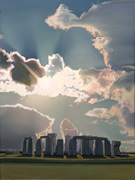
Stonehenge Series II, Al-Lat (pre-Islamic Arabia) 48 x 36 inches, Oil on Panel, 2013
North Arabian goddess of pre-Islamic times whose name is a contraction of al-Illahat, "the Goddess". Al-Lat is one of three desert goddess worshiped by the Arab people before Islam. She was called "the Mother of the Gods", or "Greatest of All". Al-Lat was worshipped as the solar deity under the appellation of Samas or Shams. She is also a Goddess of Springtime and Fertility, the Earth-Goddess who brings prosperity. Before the time of Mohammed devotees of Al-Lat circumambulated the Kabbah in Mecca (now a central shrine of Islam in Mecca’s al-Haram mosque) chanting her praises and those of her sister goddesses al-Uzza, and Manat.
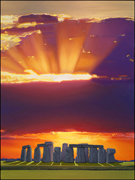
Stonehenge Series II, Yhi (Australian Aborigine) 48 x 36 inches, Oil on Panel, 2013
Yhi is an Australian Aboriginal goddess of light and creation, and a solar deity. She lived in the Dream Time and slept until a whistle awakened her. When she opened her eyes, light fell on the earth. She walked the earth and plants grew where she walked. Soon the whole world was covered with foliage. She decided that, in addition to plants, she wanted to make something that could dance. She then returned to her own world and blessed her creations with the change of the seasons and promised that, when they died, they would join her in the sky. When she disappeared the organisms thought she was not returning and were sad, but then Yhi returned to the sky with the first sunrise. When she saw that the Man she had created had no woman she turned all her power on a flower and when the man woke up the flower had turned into a woman.
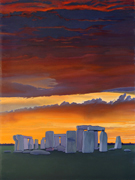
Stonehenge Series II, Wuriupranili (Australian Aborigine) 48 x 36 inches, Oil on Panel, 2013
In the mythology of the Aboriginal people of northern Australia, the Sun Woman Wuriupranili (or Wuriunpranilli) is a solar goddess whose stringybark torch is the sun. When she wakes each morning in the east she lights a small fire, which mankind sees as the first glow of dawn. She then decorates her face and body with red ochre. Often the pigment is blown into the air where it stains the clouds, resulting in a red sunrise. As Wuriupranili prepares herself for her journey across the sky the birds break into song, waking the men and women. Finally, she lights her stringybark torch from the campfire, then travels across the sky to her evening camp in the west. When she disappears below the western horizon she puts out her torch and redecorates her body with ochre, causing brilliantly-colored sunsets. As night settles, she returns to her eastern morning camp via an
underground tunnel.

Stonehenge Series II, Aodh (Celtic) 48 x 36 inches, Oil on Panel, 2013
Aodh was the name of a Celtic sun god. The Celtic sun god Aodh is an aspect of the Celtic god The Dagda. Aodh (sun god) fell in love with Ila (primal earth goddess). Their children were Kaido, the earth god, and Arudain, the fire god. The primal gods disappeared as their children rose in power. There were additional Celtic gods and goddesses named Aodh, all in some way associated with flames, fire, and/or the sun
36" x 48” (39" x 51") one painting

Stonehenge Series II, Tama-Nui-Te-Ra (Maori) 36 x 48 inches, Oil on Panel, 2013
Tama-nui-te-ra means "Great son the Sun". The Maori word for "sun" or "day" is ra. The Maori hero Maaui decided that the days were too short and caught Tamanui-Te Ra with a snare then beat him to make him travel more slowly across the sky.
48" x 32” (51" x 35") one painting

Stonehenge Series II, Xi-He (China) 32 x 48 inches, Oil on Panel, 2013
Chinese people once believed that there existed ten suns that appeared in turn in the sky during the Chinese ten-day week. Each day the ten suns would travel with their mother, the goddess Xi He, to the Valley of the Light in the East. There, Xi He would wash her children in the lake and put them in the branches of an enormous mulberry tree called fu-sang. From the tree, only one sun would move off into the sky for a journey of one day, to reach the mount Yen-Tzu in the Far West.
Tired of this routine, the ten suns decided to appear all together. The combined heat made the life on the Earth unbearable. To prevent the destruction of the Earth, the emperor Yao asked Di Jun, the father of the ten suns, to persuade his children to appear one at a time.
They would not listen to him, so Di Jun sent the archer, Yi, armed with a magic bow and ten arrows to frighten the disobedient suns. However, Yi shot nine suns, only the Sun that we see today remained in the sky. The remaining Sun is Yang and it is made of fire; while the moon is Yin. Di Jun was so angry for the death of nine of his children that he condemned Yi to live as an ordinary mortal in the earth.